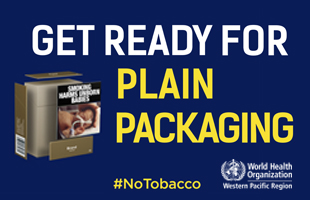
Tobacco use is one of the leading risk factors for non-communicable diseases. Around 430 million smokers, or 1 out of 3 smokers in the world lives in the Western Pacific Region. In Viet Nam, 45.3% of adult males use tobacco and regular exposure to secondhand tobacco smoke is a serious issue. Every year more than 40,000 lives are lost prematurely to tobacco-related diseases in the country.
The theme of this World No Tobacco Day is Getting Ready for Plain Packaging. WHO encourages countries all around the world to consider plain packaging as part of a comprehensive and multi-sectoral approach to tobacco control.
The impact of plain packaging
Plain packaging of tobacco products restricts or prohibits the use of logos, colours, brand images and promotional information on packaging other than brand and product names displayed in a standard colour and font style.
Studies have shown that plain packaging decreases the appeal of tobacco products, restricts the use of the pack as a form of advertising and promotion, limits misleading packaging and increases the effectiveness of health warnings. In December 2012, Australia's pioneering laws on tobacco plain packaging came into full effect. Since then, all tobacco products must be sold in drab dark brown packaging with large graphic health warnings that depict the health consequences of smoking, no logos or other advertising or promotion features.
WHO recommends that plain packaging be implemented as part of a comprehensive approach to tobacco control that includes bans on tobacco advertising, promotion and sponsorship and other packaging and labelling measures, such as health warnings.
"Plain packaging is a good public health measure because it prevents tobacco companies from using packaging as an effective marketing tool," said Dr Shin Young-soo, WHO Regional Director for the Western Pacific. "Australia has paved the way and is the first country in the world to mandate plain packaging for tobacco products. This example can be followed to reduce the attractiveness and appeal of tobacco products to consumers. International solidarity is therefore vital to overcome the challenges of tobacco and reverse its dreadful effects," said Dr Shin.
Advancing Tobacco Control in Viet Nam
Viet Nam has made great strides in combating tobacco use, including the implementation of the Tobacco Control Law. Particularly the pictorial health warnings, the progressive implementation of smoke-free environments, and the establishment and operation of the Tobacco Control Fund are great advances. However, in order to further strengthen tobacco control efforts, WHO recommends the Government of Viet Nam to consider implementing plain packaging for tobacco products as one of the key measures in reducing tobacco product consumption in the country.
“We encourage the government in Viet Nam to update the current set of pictorial health warnings, to increase the size of the warnings and consider adopting plain packaging in the near future” said Dr Lokky Wai, WHO Representative to Viet Nam. “We also recommend Viet Nam to establish a special task force to monitor and enforce the smoking ban and to initiate a hotline for the public to register complaints about the violations of smoke free environments. These are all measures that can save lives and protect public health.”
The latest Global Adult Tobacco Survey from 2015 demonstrates the impact of these tobacco control measures. The survey shows that while the smoking rate has reduced only marginally, the exposure to secondhand tobacco smoke at home, workplaces and public places has been scaled down significantly in Viet Nam.
For more information, please contact
Ms. Tran Thi Loan
Tel: +84 (0) 4 38 500 100
Email: media.vtn@wpro.who.int
